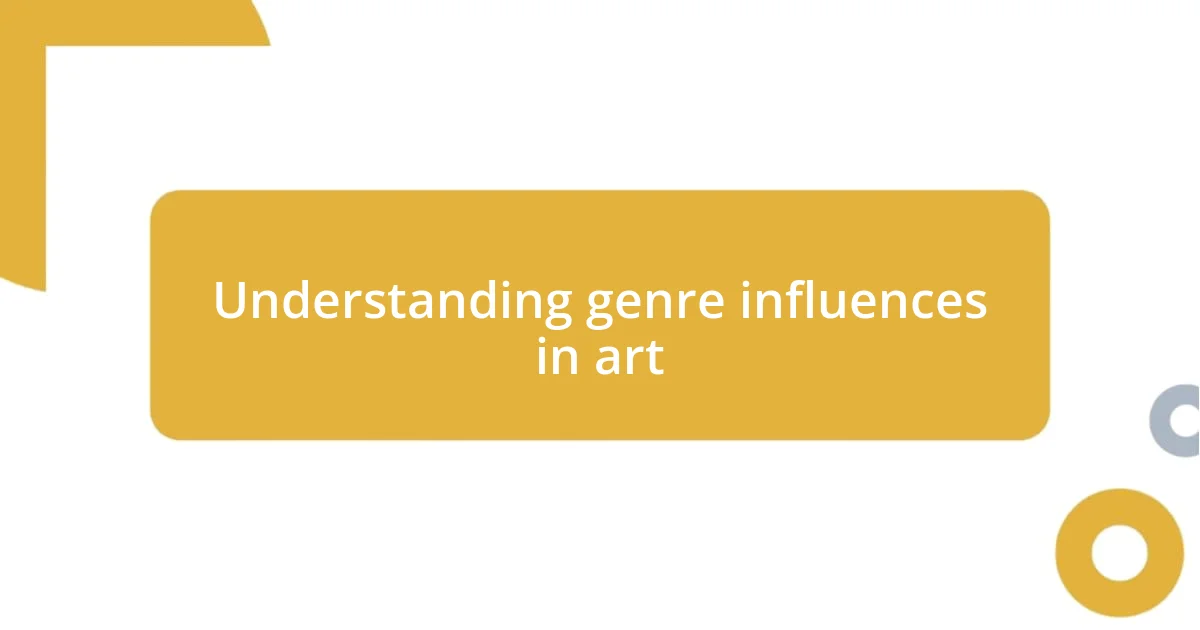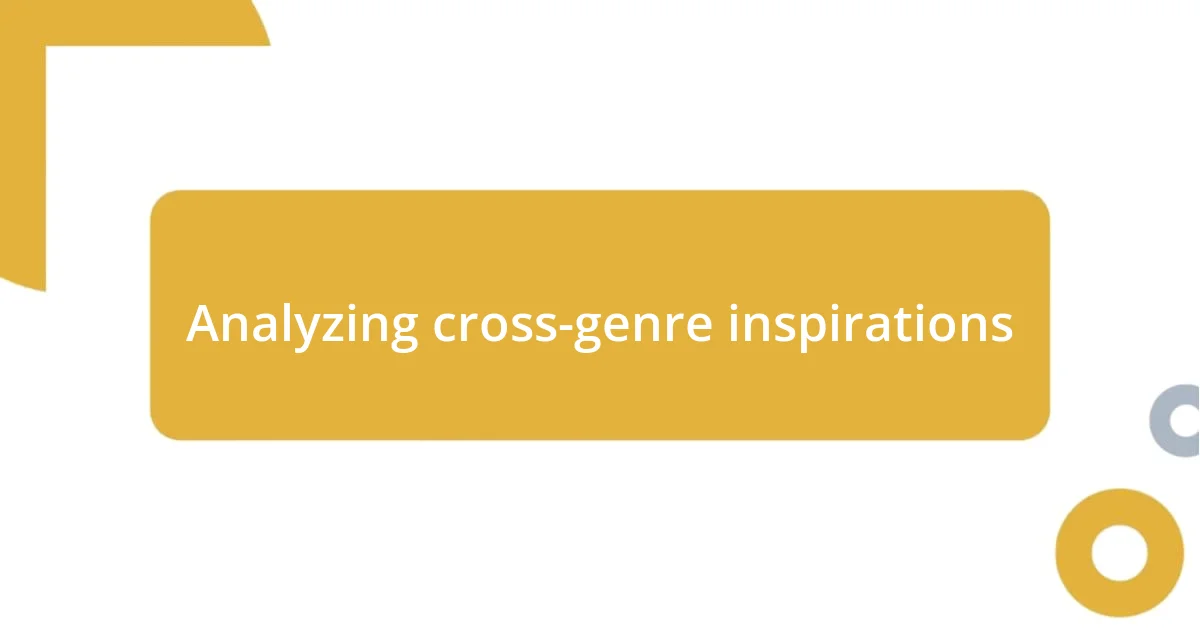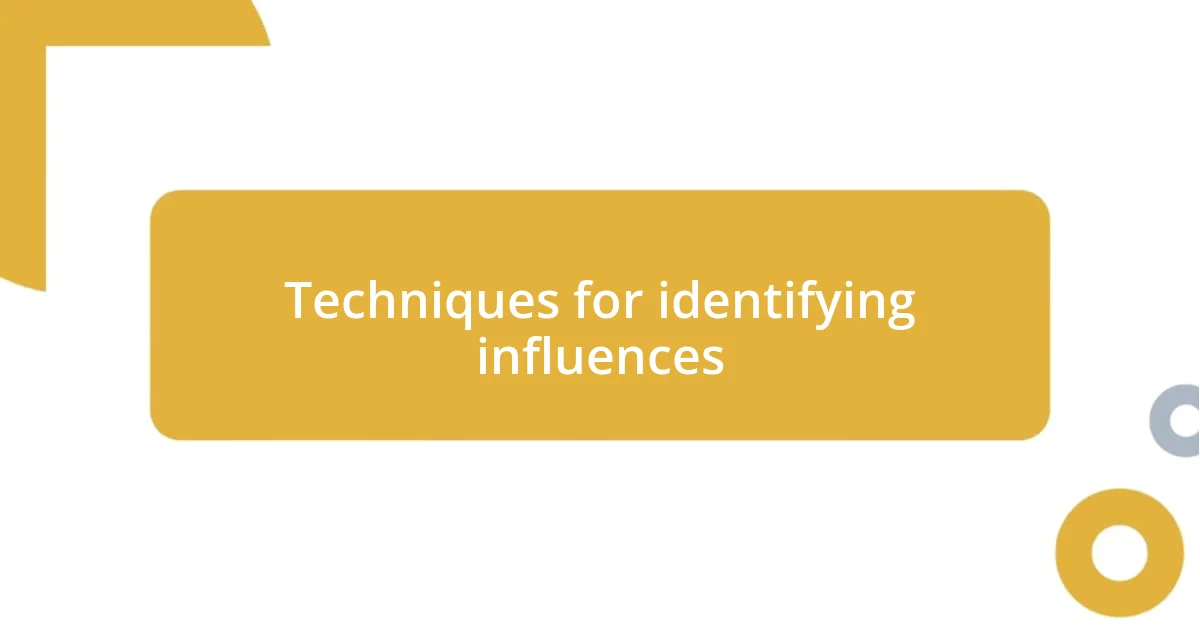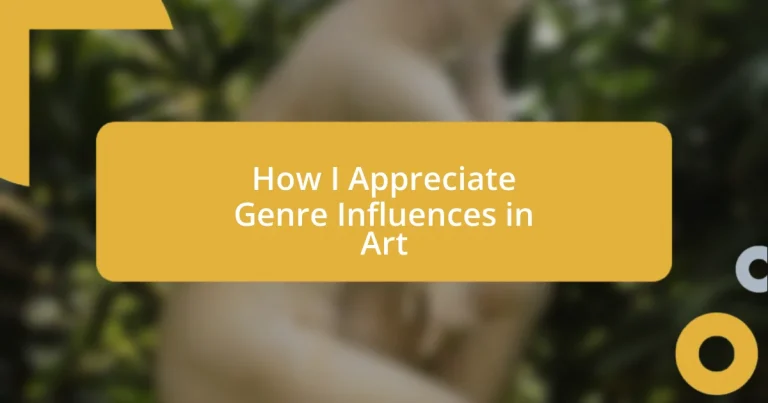Key takeaways:
- Understanding genre influences in art enhances appreciation by revealing the cultural and historical contexts behind artworks.
- Cross-genre inspirations foster creativity, allowing artists to blend styles and narratives, leading to unique and impactful expressions.
- Engaging with diverse art forms encourages exploration of personal heritage and emotional depth, enriching both the artist’s and viewer’s experience.

Understanding genre influences in art
Understanding genre influences in art is like peeling back layers of meaning in every brushstroke or sculpted form. I’ve often found myself lost in a gallery, captivated not just by the artwork, but by the distinct genres that shape the narratives they tell. Have you ever paused to consider how a piece of art reflects not just the artist’s style but also the cultural and historical context of its genre?
For instance, when I first encountered Impressionism, I felt an undeniable connection to its emphasis on light and fleeting moments. This genre emerged as a reaction to the rigid rules of academic painting, encouraging artists to capture life as it is—unfiltered and raw. Isn’t it fascinating how genres adapt and evolve, echoing the sentiments of their time while influencing each other in profound ways?
I remember a time when I explored the depths of Surrealism, the genre that seeks to unlock the imagination. The experience was surreal—not just in the art itself, but in how it forced me to confront the subconscious. How can an artist delve into the irrational and evoke such strong emotional reactions? This interplay of genres invites us to appreciate art not just as a static entity but as a dynamic conversation shaped by diverse influences and ideas.

Importance of appreciating genre influences
Recognizing the influences of various genres in art opens up a dialogue that enriches our appreciation. For example, attending an exhibition focused on both Abstract Expressionism and Cubism made me realize how different approaches to form and emotion can create a deeper understanding of artistic intent. It’s almost like a conversation across time—every style contributes to an ongoing narrative that invites us to explore beyond the surface.
- Understanding genre influences helps us connect with the artist’s intent and emotional landscape.
- It fosters a more comprehensive appreciation of art by revealing its cultural and historical roots.
- Engaging with different genres encourages open-mindedness and curiosity, enriching our personal artistic journey.

Exploring key art genres
Art genres serve as a lens through which we can examine the evolution of creative expression. When I think about the vibrant energy of Pop Art, I remember visiting a gallery where works by Andy Warhol and Roy Lichtenstein vividly engaged the senses. They celebrated consumer culture while simultaneously critiquing it, showcasing how art can reflect societal values and trends. What emotions do such artworks evoke in you, especially when you consider the intersection of art and consumerism?
In contrast, the haunting beauty of Romanticism evokes feelings of passion and introspection. I find myself drawn into the sweeping landscapes and emotional intensity present in the works of artists like Caspar David Friedrich. The genre reflects the yearning for the sublime, reminding us of nature’s power and our own emotional depths. How does the exploration of such intense emotions through genre resonate with your personal experiences in art?
Another genre that piques my curiosity is Minimalism, where less truly becomes more. During one visit to a minimalist exhibition, I was surprised by how a simple arrangement of shapes and colors could evoke such profound contemplation. This contrast between complexity and simplicity in different genres challenges our perception of what art can be. Each genre offers a pathway to a different emotional and intellectual experience, encouraging us to explore art on multiple levels.
| Art Genre | Key Characteristics |
|---|---|
| Impressionism | Focus on light and fleeting moments; a reaction against traditional forms. |
| Pop Art | Commentary on consumer culture; vibrant and engaging mediums. |
| Romanticism | Emphasis on emotion and nature; profound introspection. |
| Minimalism | Simplicity and clarity; encourages deep contemplation. |

Analyzing cross-genre inspirations
I love diving into how different genres can influence one another in art. For instance, I recently attended a hybrid exhibition that melded Surrealism with Modern Digital Art. It struck me how the playful distortions of reality in Surrealism found new life in the digital realm, transforming traditional forms into immersive experiences. What happens when the bizarre meets cutting-edge technology, and how does that shift our perception of imagination?
When I reflect on the blend of genres, I can’t help but think of the fusion between Folk Art and Contemporary practices. There’s something deeply moving in seeing traditional storytelling reflected through modern mediums. In one piece, an artist incorporated elements of folk narratives into a contemporary installation, creating a comforting yet challenging dialogue with the past. It sparked a personal connection for me—how do our roots shape how we create and experience art today?
Cross-genre inspirations truly ignite a creative spark; they encourage artists to push boundaries. I remember flipping through a book on Contemporary Art when I stumbled upon a piece that used Street Art techniques to address social justice issues. It was powerful to witness the rawness of graffiti culture intersecting with formal art spaces. This makes me wonder, how important is it for art to break free from its confines, and can that liberation lead to greater societal change?

Techniques for identifying influences
To identify influences in art, I often start by exploring the historical context of a piece. Understanding the time and place an artist worked in can reveal how societal changes shaped their creative vision. For example, when I learned about how the Great Depression affected American artists, it was eye-opening to see how their works reflected the struggles of that era. How often do we consider the world around us when viewing a piece of art?
Another technique I find effective is to analyze stylistic elements within the artwork. I recall viewing a painting that mixed thick brushstrokes typical of Van Gogh with the vibrant colors seen in contemporary street art. It made me wonder: what conversations are happening between past and present artists? An observable fusion of techniques often signals a deeper influence, providing insight into how one genre interacts with another.
Lastly, engaging with artists through interviews or artist talks offers a unique perspective on their influences. During a conversation with a local artist, they explained how their upbringing in a multicultural environment infused their work with various artistic traditions. This personal connection leads me to ask: how do our individual backgrounds shape our creativity? Discovering these layers adds richness to the experience of understanding art.

Applying influences in your art
Applying influences in your art can often feel like adding vibrant colors to a blank canvas. I remember when I experimented with combining elements of Impressionism and Urban Art to create a piece that reflected my city’s energy. The light, fleeting brushstrokes of Impressionism complemented the bold graffiti patterns, ultimately giving viewers a dynamic experience. Isn’t it fascinating how mixing styles can evoke different emotions and stories?
As I dive deeper into my creative process, I find that utilizing influences isn’t just about technique; it’s about embracing the narratives behind those influences. I recently attended a workshop where the instructor encouraged us to incorporate personal heritage into our artwork. It was a transformative moment for me, as I began interweaving stories from my family’s history, using visual language I’d seen in both modern and traditional art forms. What layers can your own life experiences add to your work?
I often think about the importance of not being afraid to mix genres, even if it feels uncomfortable at first. In my own journey, I once combined digital photography with traditional canvas painting. The initial result was messy, but that chaos sparked unexpected creativity. How often do we resist exploring the quirks and overlaps in our artistic influences? Embracing that vulnerability can lead to truly unique pieces that resonate on multiple levels.

Celebrating diversity in art genres
Celebrating diversity in art genres is like attending a vibrant festival where every tradition has its place and voice. I vividly recall my first visit to an art fair where I encountered a breathtaking fusion of cultures—African textiles interwoven with modern abstract painting. It struck me how such a blend not only showcases individual artistry but also reflects the interconnectedness of global narratives. Have you ever felt that rush of inspiration when seeing different genres come together?
Every time I explore a new art genre, I feel like I’m stepping into a world of possibilities. I remember pouring over mixed media pieces where artists used everything from found objects to digital projections. Each element told a different story, inviting the viewer to ponder: how do these diverse materials interplay to create a cohesive message? The thrill of seeing what happens when diverse influences collide is a reminder that creativity knows no boundaries.
Engaging with a variety of artistic expressions allows us to celebrate more than just the art itself; it celebrates the stories and identities behind them. I recently joined a community art project where participants represented their cultural backgrounds through various mediums. It was an eye-opening experience for me, witnessing how each person’s unique approach brought a fresh perspective to the group’s collective vision. Isn’t it incredible to think about the rich tapestry we can create when diverse influences come together?













